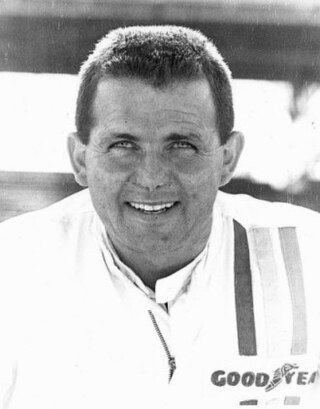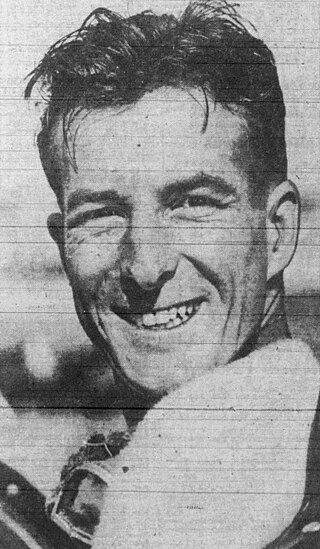
The United States Auto Club (USAC) is one of the sanctioning bodies of auto racing in the United States. From 1956 to 1979, USAC sanctioned the United States National Championship, and from 1956 to 1997 the organization sanctioned the Indianapolis 500. Today, USAC serves as the sanctioning body for a number of racing series, including the Silver Crown Series, National Sprint Cars, National Midgets, Speed2 Midget Series, .25 Midget Series, Stadium Super Trucks, and Pirelli World Challenge. Seven-time USAC champion Levi Jones is USAC's Competition Director.

Louis H Schwitzer was born in Bielitz, Austria-Hungary, and emigrated to America before World War I.

Paul Russo was an American racecar driver.
John James McGrath was an American racecar driver. McGrath died in an accident at Bobby Ball Memorial, he lost control of his car at Turn 3, crashed and flipped, dying instantly.

George Reggie "Little George" Amick was an American racecar driver, mainly competing in the American National Championship. He was killed in a crash in a USAC 100-mile (160 km) race at Daytona International Speedway.
Art Cross was an American racecar driver. He was the first recipient of the Indianapolis 500 Rookie of the Year Award in 1952.
Robert Charles Sweikert was an American racing driver, best known as the winner of the 1955 Indianapolis 500 and the 1955 National Championship, as well as the 1955 Midwest Sprint car championship - the only driver in history to sweep all three in a single season.
Chester Joseph Miller was an American racecar driver. He was killed in a crash in the south turn of the Indianapolis Motor Speedway during practice for the 1953 Indianapolis 500. During his long Indy career, Miller earned the nickname "Dean of the Speedway."
Gerald Frederick Hoyt was an American racing driver from Chicago, mainly competing in the National Championship. He died on July 11, 1955, after crashing in a sprint car race at Oklahoma City.

James Hurtubise was an American race car driver who raced in USAC Champ Cars, as well as sprint cars and stock cars. He was from the Buffalo suburb of North Tonawanda, New York. Hurtubise enjoyed a lot of success in sprint cars, champ dirt cars, and stock cars, but never achieved the success at the Indy 500 that his rookie qualifying run promised when he out qualified pole sitter Eddie Sachs by three mph, nearly breaking the 150 mph mark. "Herk" was a fan favorite throughout much of his career because of his fun-loving attitude and his hard driving style.
Ray Crawford was an American fighter ace, test pilot, race-car driver and businessman.

Samuel Dwight Hanks was an American race car driver who won the 1957 Indianapolis 500. He was a barnstormer, and raced midget and Championship cars.
Tony Lee Bettenhausen Jr. was a Champ Car team owner and driver who died in a 2000 plane crash. He was the son of former 14-time Indianapolis 500 competitor Tony Bettenhausen and the brother of 21-time Indy 500 racer Gary Bettenhausen. Another brother, Merle Bettenhausen, was critically injured in his only Indy Car start.
Thomas Wyatt Wilson Binford was an Indianapolis-based entrepreneur and philanthropist. One of Indianapolis' most influential men, Thomas W. Binford was a pioneer, visionary and civil rights leader. He participated in civic, philanthropic, cultural and political aspects of the city and state and was valued for his sensitivity, wise counsel, personal and financial support, and sincerity. In addition to his many personal interests, Binford spearheaded a group to buy the Indiana Pacers basketball team in 1975 and served as its president and general manager for one year. From 1974-1995, Binford served as the Chief Steward of the Indianapolis 500, presiding over its transition from United States Auto Club to Indy Racing League governance.

August Samuel Duesenberg was a German- born American automobile and engine manufacturer who built American racing and racing engines that set speed records at Daytona Beach, Florida, in 1920; won the French Grand Prix in 1921; and won Indianapolis 500-mile races, as well as setting one-hour and 24-hour speed records on the Bonneville Salt Flats in Utah in 1935. He also shared with his older brother, Frederick S. "Fred" Duesenberg, patents filed in 1913 and renewed in 1918 for a four-cylinder engine design and the Duesenberg Straight 8.

Howard Samuel Wilcox was an American racecar driver active in the formative years of auto racing.
Louis Frank Schneider was an American racecar driver. He won the 1931 Indianapolis 500.
Ronald Barth Duman, was an American racing driver who competed in the USAC Championship Car series and the Indianapolis 500. Duman was an accomplished driver in sprints and midgets, and won the prestigious Little 500 at Anderson Speedway in 1959 and 1960.

Charles Cleveland Merz was an American racecar driver, military officer, engineering entrepreneur, and racing official. Active in the early years of the Indianapolis 500, he later became Chief Steward of the Memorial Day Classic.
Juncos Hollinger Racing, formerly Juncos Racing, is an Argentine-American racing team competing in the NTT IndyCar Series, Indy Lights and Indy Pro 2000 Championship series in the Road to Indy ladder for IndyCar. Owned by Ricardo Juncos, who formed the team in 1997, the team was initially based in Argentina before limited racing opportunities in that country led to the team moving to the United States. The team is currently based in Indianapolis, Indiana. Following Williams F1 shareholder Brad Hollinger's entry to the team as partner in 2021, the team was renamed to Juncos Hollinger Racing.








